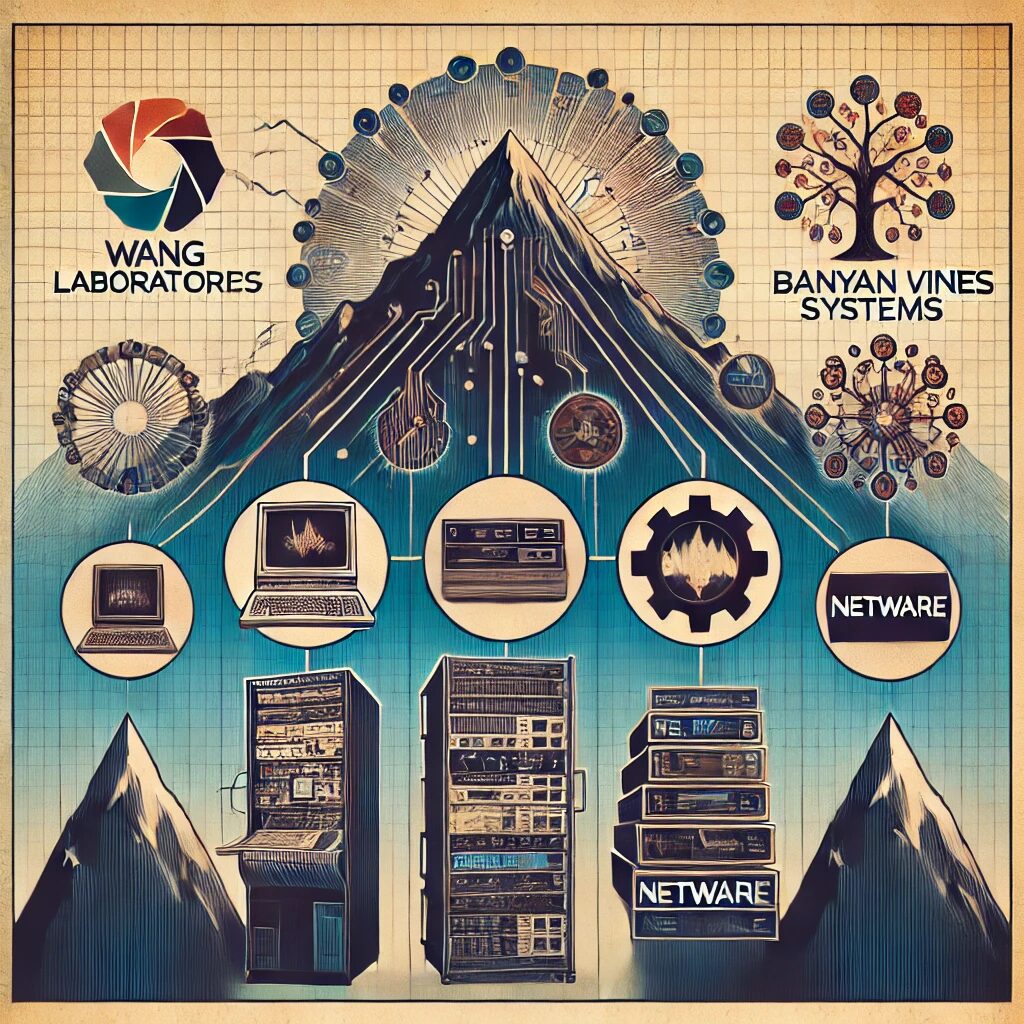Wang, Banyan, and Novell
The history of networking is rich with stories of innovation, dominance, and eventual obsolescence. Among the most notable players that once stood at the pinnacle of networking technology are Wang Laboratories, Banyan Systems, and Novell. Each of these companies shaped the landscape of enterprise networking in their time, only to eventually fade into the background as the industry evolved. This article delves into their rise, market focus, and the factors that led to their decline.
Wang Laboratories: The Innovator in Business Computing
Rise to Prominence
Wang Laboratories, founded in 1951 by Dr. An Wang, initially made its mark with magnetic core memory, a critical technology for early computers. However, the company’s rise to prominence truly began in the 1970s and 1980s, when it shifted its focus to business computing. Wang developed a series of minicomputers and workstations that became a staple in offices worldwide, particularly with the introduction of the Wang 2200 and the Wang VS series.
Market Focus
Wang’s primary market focus was on business computing, particularly in small to medium-sized enterprises. The Wang 2200, released in 1973, was one of the first desktop computers designed specifically for business use. It featured a built-in BASIC programming language and was highly popular for applications like accounting, payroll, and word processing.
The Wang VS (Virtual Storage) series, introduced in 1977, further solidified Wang’s reputation as a leader in business computing. The VS series offered a powerful, integrated system that could handle a wide range of business applications, from data processing to office automation. Wang’s systems were known for their reliability, ease of use, and the ability to create complex applications without requiring extensive programming knowledge.
Decline and Obsolescence
The decline of Wang Laboratories began in the mid-1980s, as personal computers (PCs) from companies like IBM and Apple started to dominate the market. These PCs were not only more affordable but also offered greater flexibility and compatibility with a wide range of software. Wang’s systems, which were largely proprietary, could not easily integrate with the rapidly growing PC ecosystem.
Moreover, Wang’s focus on its proprietary VS series and its reluctance to embrace the emerging PC standards put it at a disadvantage. As businesses increasingly adopted PC-based networks, Wang’s market share dwindled. The company attempted to pivot by introducing new products, including imaging and networking solutions, but these efforts were not enough to reverse its decline. By the early 1990s, Wang Laboratories had filed for bankruptcy, marking the end of its era as a major player in the business computing industry.
Banyan Systems: The Pioneer of Enterprise Networking
Rise to Prominence
Founded in 1983, Banyan Systems was at the forefront of enterprise networking with its Banyan VINES (Virtual Integrated Network Service) product. VINES was a network operating system that enabled organizations to connect large numbers of users across various locations, offering superior scalability and reliability compared to its contemporaries.
Market Focus
Banyan’s primary market focus was on large enterprises that needed to manage extensive, geographically dispersed networks. VINES was particularly popular in government agencies and large corporations due to its robust directory services and high-performance networking capabilities. Banyan’s technology allowed for the integration of different types of networks, including Ethernet and Token Ring, which was a significant advantage in the heterogeneous networking environments of the time.
Decline and Obsolescence
Despite its early success, Banyan began to lose ground in the 1990s as TCP/IP emerged as the dominant networking protocol, and Microsoft’s Windows NT began to take over the enterprise market. VINES, which was based on the proprietary Internetwork Packet Exchange/Sequenced Packet Exchange (IPX/SPX) protocol, could not compete with the growing popularity of open standards. Banyan’s attempts to adapt to the new networking landscape were too little, too late. By the late 1990s, Banyan had shifted its focus to Internet software, but it was eventually acquired by a larger firm and faded from the networking scene.
Novell: The Networking Titan
Rise to Prominence
Novell was founded in 1979, but it wasn’t until the introduction of Novell NetWare in 1983 that the company became a dominant force in networking. NetWare was a network operating system that allowed PCs to share files and printers over a LAN. During the 1980s and early 1990s, NetWare was the de facto standard for PC networking, and Novell became synonymous with networking in the enterprise space.
Market Focus
Novell’s primary market focus was small to medium-sized businesses and enterprises that needed reliable and efficient networking solutions. NetWare’s ability to integrate seamlessly with various hardware platforms made it a versatile choice for organizations looking to connect their growing PC networks. Novell also invested heavily in directory services, with Novell Directory Services (NDS) becoming one of the most advanced and widely used directory systems of its time.
Decline and Obsolescence
The decline of Novell began with the rise of Microsoft Windows NT, which integrated networking capabilities directly into the operating system. Unlike NetWare, Windows NT provided a more user-friendly interface and better integration with other Microsoft products, making it an attractive choice for businesses. Novell’s inability to compete effectively with Microsoft, combined with strategic missteps such as the delayed transition to IP-based networking, led to a steady erosion of its market share. By the late 1990s, Novell had lost its position as the leader in networking, and although it continued to operate in various capacities, the company was eventually acquired by The Attachmate Group in 2011 and later by Micro Focus.
Conclusion
Wang Laboratories, Banyan Systems, and Novell were once towering giants in the world of networking, each playing a critical role in the development of enterprise networking technologies. However, the rapid pace of technological change, combined with strategic missteps and the rise of new competitors, led to their eventual decline. Their stories serve as a reminder of the challenges of maintaining dominance in an ever-evolving industry, where innovation is relentless, and yesterday’s leaders can quickly become today’s footnotes.


